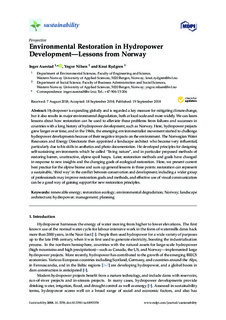| dc.description.abstract | Hydropower is expanding globally and is regarded a keymeasure formitigating climate change, but it also results inmajor environmental degradation, both at local scale andmore widely. We can learn lessons about how restoration can be used to alleviate these problems from failures and successes in countries with a long history of hydropower development, such as Norway. Here, hydropower projects grew larger over time, and in the 1960s, the emerging environmentalistmovement started to challenge hydropower developments because of their negative impacts on the environment. The NorwegianWater Resources and Energy Directorate then appointed a landscape architect who became very influential, particularly due to his skills in aesthetics and photo documentation. He developed principles for designing self-sustaining environments which he called “living nature”, and in particular proposed methods of restoring barren, unattractive, alpine spoil heaps. Later, restoration methods and goals have changed in response to new insights and the changing goals of ecological restoration. Here, we present current best practice for the alpine biome and sumup general lessons in three points: restoration can represent a sustainable, ‘third way’ in the conflict between conservation and development; including a wider group of professionalsmay improve restoration goals andmethods, and effective use of visual communication can be a good way of gaining support for new restoration principles. | |
